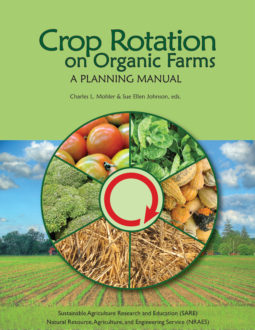Many small organic vegetable farms in the northeastern US begin on land that has been a hay field or pasture for several years. Often the previous manager applied no fertilizers or pesticides for several years, and thus the land can be quickly certified as organic. The long period in sod will have improved soil physical quality, but export of several tons of hay per acre over several years may have depleted soil nutrients.
Old hay fields and pastures are excellent habitats for establishment of perennial weed species. Also, some forage grasses like smooth brome can be challenging weeds in organic vegetable fields. At the start, making a systematic assessment of the plant species present and mapping potential weed problems may be worthwhile. Weeds of the Northeast is a useful guide for weed identification (116). Taking an initial survey will help you avoid spreading a few patches of weeds like johnsongrass or bindweed all over the field during tillage. If any bad perennial weeds are abundant, consider choosing a different field or using conventional methods to get the weed under control before attempting the transition. If taking an initial weed survey is not practical, it will be safest to assume that perennial weeds pose a substantial problem. Reducing weed numbers to manageable levels at the outset will pay lasting dividends in reduced labor over the coming years. Consequently, a full growing season of cover crops and fallow periods is often a good investment when converting old sod to vegetable production (see sidebar 6.1). If perennials show up in the fall cover crop after the fallow, a second year of fallow and cover crops may be necessary.
“Old hay fields and pastures are excellent habitats for establishment of perennial weed species.”
If a full year of summer fallow and cover crops to control weeds and improve soil quality is not practical, working a summer fallow period into the first year’s cropping sequence may help get the weeds under control. For example, a fallow can be worked in after a spring lettuce crop or before fall broccoli. However, avoid leaving the soil bare in the spring or mid to late fall, when conditions may prevent working the soil for long periods, as this will allow weed growth and nutrient leaching.
Whether or not the transition process begins with a full season of fallow and cover crops, the first cash crop after a sod should be transplanted, not direct seeded. In general, transplants compete better with weeds because they begin larger, and they can be cultivated or hoed sooner after planting. Also, unless mulch is used, avoid widely spreading vine crops like winter squash or pumpkins in the first two years after sod, because these become impossible to weed late in their growth cycle.
SIDEBAR 6.1
Summer Fallow for Weed Management during Transition from Sod to Vegetables
If possible, break the sod in the fall so that it can decompose over the winter. Use moderately deep tillage (for example, 8 inches) to disrupt root systems. Then level the field and sow a winter cover crop like rye. The cover crop will capture nutrients that could otherwise be lost by leaching and will protect the soil from erosion and puddling.
In the spring, mow the cover crop once or twice to prevent seed production and prevent stems from becoming too long and stringy to incorporate. Incorporate the cover crop in early summer. Cultivate the soil thoroughly but shallowly at about three-week intervals through the hot part of the growing season. This causes most perennial weeds to repeatedly sprout, without allowing them time to replenish food reserves in their roots and rhizomes. It will also flush out and kill a lot of weed seeds. A spring tooth harrow is ideal for the task because it brings roots to the surface, where they will dry out and die. Avoid repeatedly rototilling the soil, as this will damage soil structure. In the late summer or fall, again plant a cover crop to restore soil organic matter lost during the fallowing and to protect the soil over the winter. A cover crop that will winter-kill is best before early-planted crops like pea and early lettuce. Winter-hardy cover crops are best before summer-planted crops like tomatoes.
Eric and Anne Nordell developed the strategy outlined above during the transition process on their northern Pennsylvania farm. Their farm now has excellent soil quality and is one of the most weed-free organic farms in the northeast US.
In general, working a lot of cover crops into the rotation during the first few years of transition is advisable to build soil physical quality, increase nutrient storage, and compete with weeds. Soil that has been built up in physical quality and nutrient storage over several years will often support multiple vegetable crops within a single growing season. During transition, however, multiple cropping may result in low yields and poor-quality produce, whereas investing in soil development and weed control through cover cropping and mulching will provide a basis for long-term prosperity.
